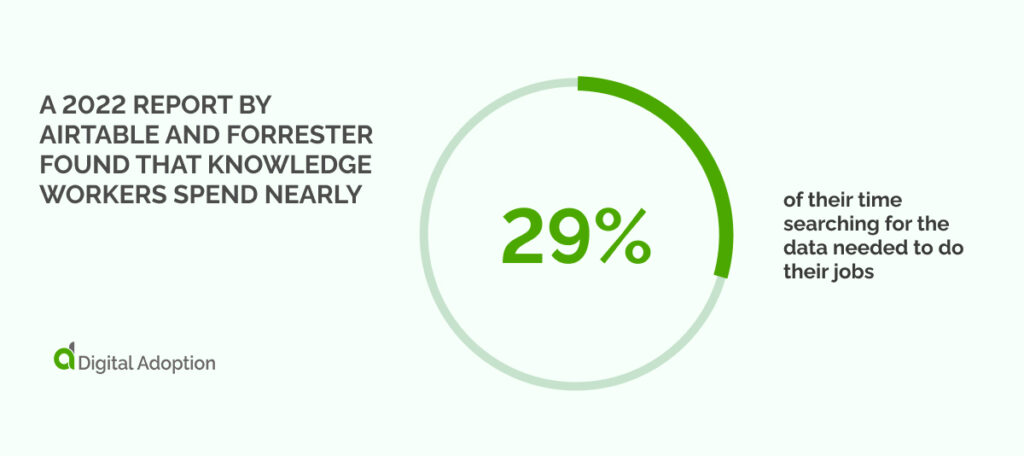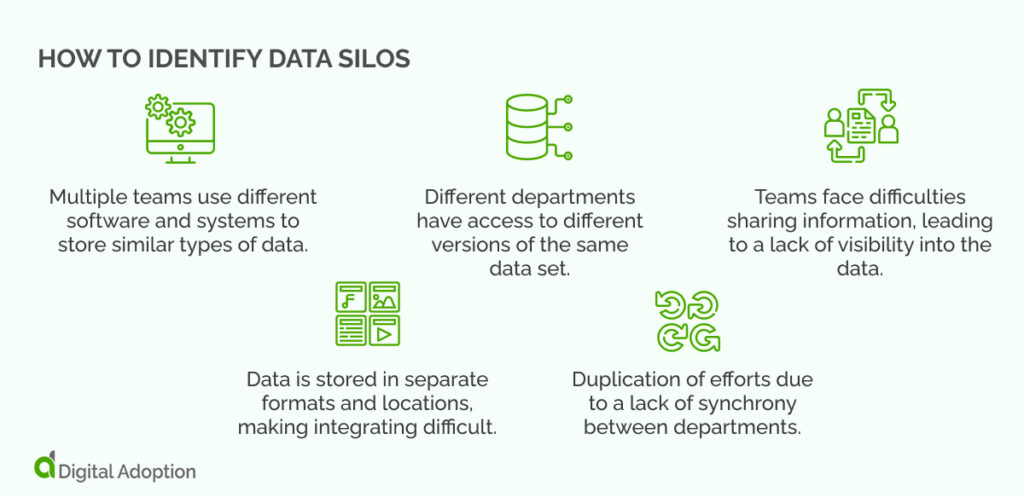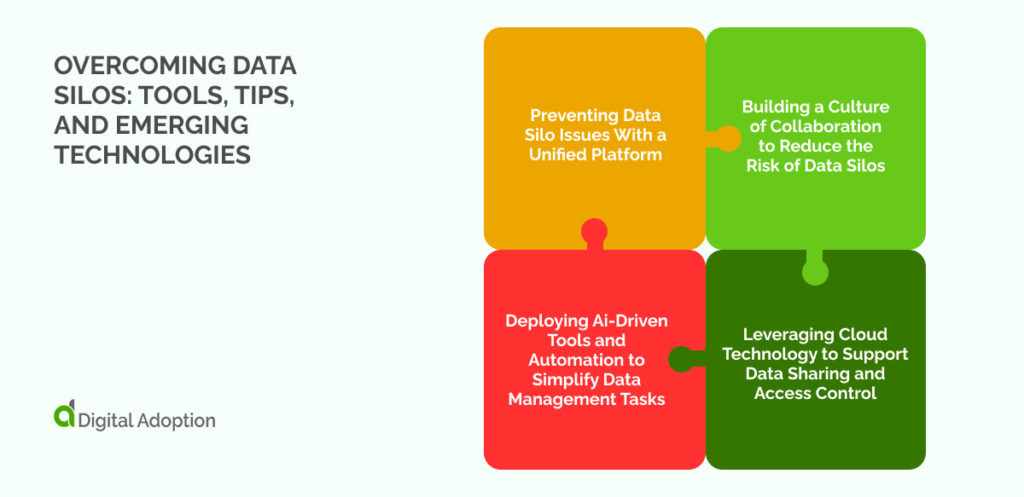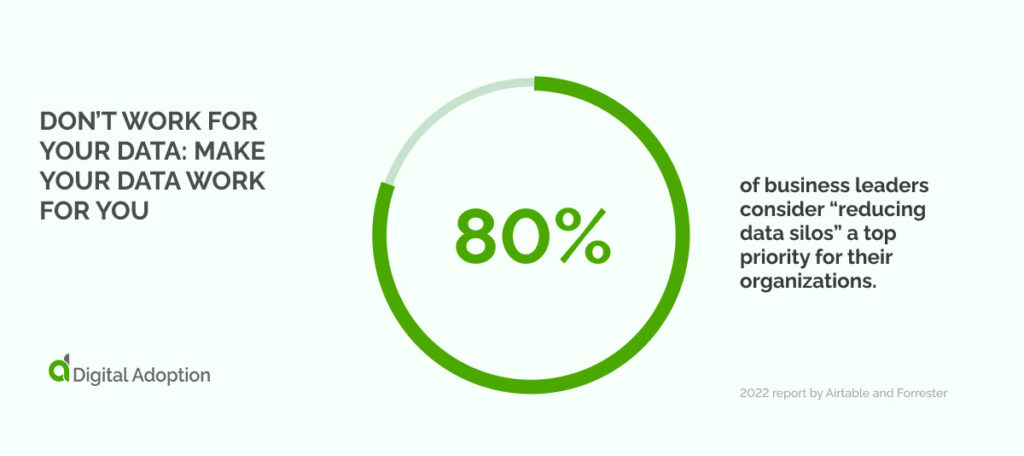Business leaders and Chief Information Officers (CIOs) constantly seek ways to optimize their organization’s data operations to maximize efficiency and productivity.
But bubbling under the surface is a phenomenon that threatens to undo all that good work.
A 2022 report by Airtable and Forrester found that knowledge workers spend nearly 29% of their time searching for the data needed to do their jobs.

In this article, we’re shining a light on that lurking beast. That’s right. We’re talking about data silos.
The trickiest thing about data silos is that, in some ways, they can prove useful— for organizing certain processes within an organization. However, they can be a major impediment to successful decision-making if left unchecked.
They hinder digital transformation and cost organizations millions of dollars in lost data, inefficient operations, and customer dissatisfaction. Organizations must adopt a modern data architecture to break down the barriers between their various departments or teams. This way, they can access all the information they need quickly and efficiently without going through manual processes.
Worse, data silos can form even if you have a robust data lifecycle management process.
We will explore the downsides of relying on data silos and the strategies you can use to eliminate them and create a more streamlined environment in your organization.
What is Data Silos, and Why Do They Occur?
Data silos refer to the isolation of data within different departments or systems in a business, leading to a lack of shared understanding and collaboration.
Simply put, different teams get accustomed to working only within their data environment, leading to a situation where data is stored in inconsistent formats and accessed through different applications.
This disconnect hinders efficient decision-making and restricts access to information, ultimately complicating business operations.
Data silos occur for various reasons, including departmental budgeting, incompatible data platforms, and a lack of a unified approach to data management.
To maximize business performance, breaking down data silos and establishing a systematic approach to managing and sharing data throughout your organization is essential.
The Dark Side of Data Silos: Pitfalls to Watch Out For
We live in a world where data is king, and every business seeks ways to make sense of everything.
As businesses grow, so does their data, and they often turn to data silos to help manage the influx. Sometimes this is intentional. Sometimes it’s not.
While data silos can be a valuable tool, there is a dark side to these information kingdoms.
One pitfall to watch out for is the lack of collaboration between departments and teams, often arising from silos. Organizations can become echo chambers, where each unit is focused solely on its own data without considering the bigger picture.
This can lead to missed opportunities, duplicated efforts, and a lack of innovation.
To avoid these pitfalls, it’s important to break down data silos and encourage cross-functional collaboration.
By doing so, your business can reap the full benefits of its data and unlock new insights and opportunities.
How to Identify Data Silos

Before you can combat data silos, you need to master the knack of identifying them within your organization.
There are several warning signs to look out for when identifying data silos. These include:
- Multiple teams use different software and systems to store similar types of data.
- Different departments have access to different versions of the same data set.
- Teams face difficulties sharing information, leading to a lack of visibility into the data.
- Data is stored in separate formats and locations, making integrating difficult.
- Duplication of efforts due to a lack of synchrony between departments.
The trick to identifying data silos is simple but not easy.
You need to talk to your teams, audit their data, and understand what data they use for what purposes. In larger organizations, identifying data silos and strategizing solutions would fall to the Chief Data Officer or Chief Data Analytics Officer.
Overcoming Data Silos: Tools, Tips, and Emerging Technologies

Data silos aren’t a new problem. Rather, we think that the inability of humans to share information has been a difficult problem to overcome for many centuries.
But in a way, that’s good news because it means there are plenty of tools, tips, and emerging technologies to help you deal with the problems caused by data silos.
We’ve listed some of our top solutions and broken them down to explain how they can help you overcome data silos for good.
Preventing Data Silo Issues With a Unified Platform
Data silos can be frustrating obstacles in any organization.
Data can become scattered across multiple systems and departments, making it difficult to retrieve and analyze. Not only can this cause delays in decision-making, but it can also lead to inaccurate data and missed opportunities.
Fortunately, there is a solution to these challenges: a unified platform.
You can easily access and analyze information in real-time by integrating all your data sources into one system.
This lets you make more informed and data-driven decisions, ultimately helping your organization thrive.
Building a Culture of Collaboration to Reduce the Risk of Data Silos
Building a culture of collaboration can be a game-changer in breaking down data silos and ensuring that important data is shared across your organization.
By promoting teamwork and communication, organizations can foster an environment where data is shared seamlessly and decision-making becomes more inclusive and effective.
Collaboration is key to the success of any organization looking to reduce the risk of data silos.
Leveraging Cloud Technology to Support Data Sharing and Access Control
Cloud technology has revolutionized the way we handle data sharing and access control.
With cloud technology, you can easily store and share large amounts of data with other people or devices. This means you can access your data from anywhere and anytime, as long as you have an internet connection.
Cloud technology also provides an added layer of security, ensuring that access to your data is only granted to authorized users— but giving users access to data is simpler than ever.
Leveraging cloud technology is not only user-friendly but also saves time and resources that could have been spent on maintaining data servers.
By utilizing cloud technology to support data sharing and access control, you are taking a step forward in securing your data and making it more efficiently accessible— which goes a long way towards fighting data silos.
Deploying Ai-Driven Tools and Automation to Simplify Data Management Tasks
As businesses accumulate vast amounts of data, managing and making sense of it becomes increasingly complicated.
Enter AI-driven tools, which allow for efficient data management through automation.
With these tools, tasks such as data categorization, cleaning, and analysis are simplified, saving businesses valuable time and resources.
The beauty of AI-driven tools is that they can learn and adapt to new situations, making them an essential part of any data management strategy.
By embracing this technology, you can move away from manual data management methods and focus on using your data to drive growth and success.
Don’t Work For Your Data: Make Your Data Work For You

Overcoming data silos takes time and more than a little elbow grease, but successful business leaders know that the long-term rewards are worth the short-term costs.
The same 2022 report by Airtable and Forrester found that 80% of business leaders consider “reducing data silos” a top priority for their organizations.
By understanding why data silos occur and what the common pitfalls are, you can proactively build strategies to minimize their risk.
Collaboration is key in fostering an environment where data silos cannot easily find a foothold. Cloud technology and AI-driven tools offer accessibility, convenience, and scalability, enabling seamless sharing and access control.
In today’s highly competitive business landscape, data can be an anchor that eats up work hours and drains your resources. Or it can be your most powerful tool for honing your competitive edge.













